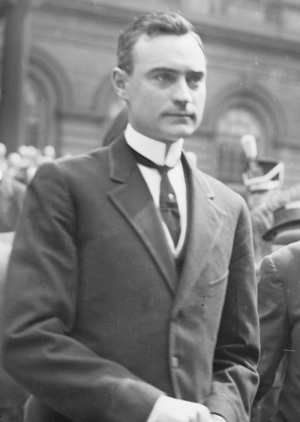John Purroy Mitchel: Difference between revisions
(Created page with ";New York - MCMXXX [[]] <br> <br> == Addressed As == == Appearance == == Background == == Personality == == Recent Events == ---- <br> ----") |
No edit summary |
||
| (4 intermediate revisions by the same user not shown) | |||
| Line 1: | Line 1: | ||
;[[New York - MCMXXX]] | ;[[New York - MCMXXX]] | ||
[[]] | [[File:John Purroy Mitchel in 1914.png|300px]] | ||
<br> | <br> | ||
<br> | <br> | ||
== Addressed As == | == Addressed As == | ||
Deceased or Former Mayor | |||
== Appearance == | == Appearance == | ||
== Background == | == Background == | ||
John Purroy Mitchel (July 19, 1879 – July 6, 1918) was the 95th mayor of New York from 1914 to 1917. At 34, he was the second-youngest mayor and he is sometimes referred to as "The Boy Mayor of New York." Mayor Mitchel is remembered for his short career as leader of reform politics in New York as well as for his early death as a US Army Air Service officer in the last months of World War I. Mitchel's staunchly-Catholic New York family had been founded by his paternal grandfather and namesake, John Mitchel, an Ulster Presbyterian Young Irelander who became a renowned writer and leader in the Irish independence movement and as a staunch supporter of the Confederate States. | |||
Reformers praised him. Oswald Garrison Villard, the editor of The Nation, said he was "the ablest and best Mayor New York ever had." Former President Theodore Roosevelt, endorsing Mitchel's re-election bid in 1917, stated that he had "given us as nearly an ideal administration of the New York City government as I have seen in my lifetime." However, even his staunchest supporters admitted he was a poor politician who was too aloof from the ordinary voters and too concerned with "scientific" urban management. He still won in a landslide in 1913 but lost the Republican primary in 1917. | |||
== Personality == | == Personality == | ||
== | == Death == | ||
After failing to get re-elected, Mitchel joined the Air Service as a flying cadet, completing training in San Diego and obtaining the rank of major. On the morning of July 6, 1918, when returning from a short military training flight to Gerstner Field, near Lake Charles, Louisiana, his plane suddenly went into a nose dive, causing Mitchel to fall from his plane due to an unfastened seatbelt. Mitchel plummeted 500 feet (150 m) to his death, his body landing in a marsh about a half mile south of the field. | |||
Mitchel's body was returned to Manhattan, New York City. His funeral was held at Saint Patrick's Cathedral, and he was buried in Woodlawn Cemetery in The Bronx, New York City on July 11, 1918. | |||
---- | ---- | ||
<br> | <br> | ||
---- | ---- | ||
Latest revision as of 22:40, 25 April 2022
Addressed As
Deceased or Former Mayor
Appearance
Background
John Purroy Mitchel (July 19, 1879 – July 6, 1918) was the 95th mayor of New York from 1914 to 1917. At 34, he was the second-youngest mayor and he is sometimes referred to as "The Boy Mayor of New York." Mayor Mitchel is remembered for his short career as leader of reform politics in New York as well as for his early death as a US Army Air Service officer in the last months of World War I. Mitchel's staunchly-Catholic New York family had been founded by his paternal grandfather and namesake, John Mitchel, an Ulster Presbyterian Young Irelander who became a renowned writer and leader in the Irish independence movement and as a staunch supporter of the Confederate States.
Reformers praised him. Oswald Garrison Villard, the editor of The Nation, said he was "the ablest and best Mayor New York ever had." Former President Theodore Roosevelt, endorsing Mitchel's re-election bid in 1917, stated that he had "given us as nearly an ideal administration of the New York City government as I have seen in my lifetime." However, even his staunchest supporters admitted he was a poor politician who was too aloof from the ordinary voters and too concerned with "scientific" urban management. He still won in a landslide in 1913 but lost the Republican primary in 1917.
Personality
Death
After failing to get re-elected, Mitchel joined the Air Service as a flying cadet, completing training in San Diego and obtaining the rank of major. On the morning of July 6, 1918, when returning from a short military training flight to Gerstner Field, near Lake Charles, Louisiana, his plane suddenly went into a nose dive, causing Mitchel to fall from his plane due to an unfastened seatbelt. Mitchel plummeted 500 feet (150 m) to his death, his body landing in a marsh about a half mile south of the field.
Mitchel's body was returned to Manhattan, New York City. His funeral was held at Saint Patrick's Cathedral, and he was buried in Woodlawn Cemetery in The Bronx, New York City on July 11, 1918.
